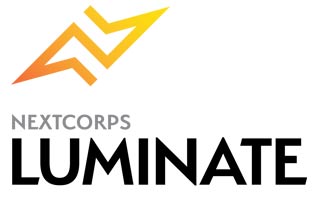ROCHESTER, N.Y., Sept. 24, 2021 — 
Ten startups from around the world will gather virtually to compete for up to $2 million in follow-on funding from Empire State Development’s Finger Lakes Forward Upstate Revitalization Initiative.
The finalists of the Luminate Accelerator’s fourth cohort will deliver pitches Sept. 30 in front of a live virtual audience and a panel of judges.
Members of the audience will have an opportunity to vote for their favorite pitch, with the winner of that vote receiving the Audience Choice Award and $10,000.
The winner will be chosen by a panel of judges made up of members of the optics and photonics industry, as well as some members of the finance sector.
“Every cohort is impressive — hardworking and committed to bringing their ideas to life. Earlier cohorts have focused on more high-level systems, while this group of companies brings a focus on core, fundamental science at a component level,” Sujatha Ramanujan, managing director of the Luminate Accelerator, told Photonics Media. “Like all cohorts, the technologies being innovated by this cohort include a wide range of one-of-its kind, or industry-first, solutions.”
Expert panel
In addition to the technology pitchers, the 2021 finals will feature a panel discussion with distinguished women in science and investment, focusing on the need to address gaps that exist today for underserved or underrepresented founders.

Susan Houde-Walker, CEO of LMD Power of Light Corp. Courtesy of Luminate.
The panelists are Sujatha Ramanujan, Managing Director, Luminate; Dr. Susan Houde-Walter, CEO of LMD Power of Light Corp. (formerly LaserMax, Inc.); Dr. Manjari Chandran-Ramesh, a Deep-Tech and Software Venture Investor at IP Group PLC and a non-executive director at several companies; Marcia Lesky, Senior Director for Diversity, Inclusion & Volunteer Cultivation at Optica; Leslie Kimerling, CEO and co-founder of Double Helix Optics and inaugural winner of the 2018 Luminate competition.
“This panel will shed light on the impact, as well as the challenges, women have had in what have traditionally been male-dominated industries. We hope that attendees will recognize that creativity and innovation are gender-neutral, and we trust that attendees will be inspired to make more inclusive decisions in their own businesses,” said Houde-Walter, who was the first female faculty member of the Institute of Optics at the University of Rochester.
“A key aspect that accelerators particularly help with is how to raise the right type of funding to turn initial ideas into functioning businesses,” said Chandran-Ramesh, a Ph.D. from the University of Oxford and a Rhodes Scholar.
“While this can be achieved with mentors and nonexecutive directors on the board, underserved and underrepresented founders often can lack access to this invaluable advice and accelerators can provide these fundamental aspects of creating a business.”
“Part of the aim of the panel, as well as its message, is to help move ideas into commercialization stage — and, once there, into all reaches of the market,” Kimerling said.
“It is important to keep working on closing gaps like these by not only inspiring more minorities and women to go into fields like optics and photonics, but by also helping them to take their ideas out of a lab and into the marketplace."
Layer Metrics: A new field of metrology
Competing for the prize money in Cohort 4 are Andluca Technologies; Dynocardia; Infrascreen SA; Layer Metrics; Mesodyne; Momentum Optics; OSCPs Motion Sensing; Owl AI; PreAct Technologies; and 2EyesVision. Technologies range from smart glass, to optical inspection, to power generators, to single-camera 3D imaging.
Layer Metrics, from Wilmington, Del., has developed what it calls a “new field of metrology” called “spectroferometry.”

Layer Metrics CEO Clare Murphy says the Del.-based company has developed a “new field of metrology” called “spectroferometry.” The company’s solution produces parallel, synchronized metrology that is smaller, faster, and more cost effective than discrete systems. Courtesy of Layer Metrics via Luminate.
“Our patent-pending Spectroferometer is a multi-sensor fusion technology with parallel optical processing enabled by integrated photonics,” said Layer Metrics’ CEO Clare Murphy, in an email correspondence with Photonics Media.
“This transformational approach will overcome limitations of currently used discrete, fragmented technologies, to deliver a new fully integrated measurement suite from a single integrated instrument.”
The precision measurement and optical inspection system is designed for use with 3D printers, where it captures critical data points at each layer, in situ, and in real time with a small data footprint.
“Just like integrated circuits bring together a set of electronic circuits onto a single chip, our integrated metrology brings together a set of test and measurement systems into a single instrument,” Murphy said.
“The result is parallel, synchronized metrology that is smaller, faster, and less expensive than discrete systems.”
Owl AI: Monocular thermal ranging
Owl AI, from Fairport, N.Y., has developed an imaging platform based on a monocular camera, capable of generating a 3D point cloud. The technology uses high- speed thermal imaging, which enables the camera to generate images regardless of weather conditions.
“Visual cameras degrade precipitously under certain conditions,” Owl co-founder and CEO Chuck Gershman said. “You can drive our sensor directly into the setting sun, and you won’t see any glare.”
The company’s technology takes computer vision approaches, commonly used with vision cameras, and applies them for thermal imaging applications. Owl AI’s solution can produce high-resolution images in monochrome. Trained AI and machine learning software, paired with optics, transform 2D images into a 3D point cloud, which can then be visualized and measured in real time.
“Owl is the only company in the world that can generate accurate depth perception from native 2D thermal imaging using one camera,” Gershman said in an article on Luminate.org.
"We call this monocular thermal ranging."
The company has an eye on the autonomous vehicle market, though it is currently focused on integration into advanced driver-assistance systems. Increased safety is a critical implication the solution can deliver.
“One robotaxi company told us, ‘If you could realize that technology, you could disrupt the whole market,’” Gershman said.
Andluca Technologies: Electrochromic smart glass

Andluca co-founder and CEO Nick Davy. The company’s smart glass technology can reduce building energy use by up to 40%. Its UV-solar-powered smart glass demonstrates 82+% transparency in the visible range, and 75% internal quantum efficiency in the near-ultraviolet range. Courtesy of Andluca Technologies via Luminate.
Princeton University spinout company Andluca Technologies has developed smart glass technology that can reduce building energy use by up to 40%. The company’s UV-solar-powered smart glass demonstrates 82+% transparency in the visible range and 75% internal quantum efficiency in the near-ultraviolet range. Anduca’s solar-powered electrochromic glass system avoids the need for external wiring during installation, saving costs and easing incorporation.
“Windows account for approximately 10% of the U.S. carbon footprint. Additionally, each year over $50 billion is wasted in energy due to inefficient windows,” Andluca co-founder and CEO Nick Davy told Photonics Media in an email.
“For years electrochromic glass has been lauded as a potential solution to these issues as it is the most effective window technology in the market at reducing building energy consumption (up to 40%) and peak power demand (20%). However, using these windows to improve existing commercial buildings is expensive and disruptive due to external wiring. The wireless nature of our smart glass systems means installation can be carried out simply by glaziers, without major disruption to the space, and at a reasonable price.”
After Andluca’s transparent solar cells complete the conversion of near-ultraviolet light into electricity, an onboard printed circuit board modulates the electricity and allows for access to a connected device — in this case, Andluca’s smart glass.
All necessary hardware, including the board, is proprietary and concealed within the frame of the company’s flagship system, Davy said.
More information and attendance information
To attend the virtual event, visit www.bit.ly/2XSXJyD. Applications for the fifth round (cohort) of the Luminate competition are now open and will be accepted until Jan. 10, 2022.
Luminate NY is administered by NextCorps.
For more information about Luminate NY, visit www.luminate.org.
For more information about NextCorps, visit www.nextcorps.org.